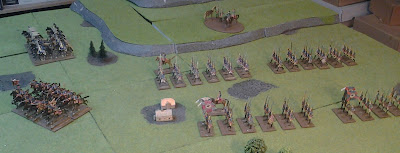This is an attempt to write a very detailed "pip-by-pip" account of every phase and initiative, and every card used.
Turn 1, phase 1
1st initiative roll: 7:6 for the Empire, they can turn one card (Dress Lines). A dramatic start :)
2nd ini: 9:9, turn ends. Both armies seem to be less than half awake at the early hour. But now they get going:Turn 2, phase 1
1st roll: 8:6 Empire, two Dress Lines
2nd roll: 11:2 Prussians, i.e. 6:3 pips
- Prussian Inf move (3 pips)
- 2 useless cards
- Turn over Cavalry move
- Empire Inf move (3 pips)
3rd roll: 12:5 Prussians, 5:2 pips
- Prussian cavalry moves (1 pip)
- Officer check (1 pip to turn, 1 turn to move the commander)
- Turn cavalry move card
- Empire turns Command Indecision, ending the initiative (this was just added as I realized I forgot that when creating the sequence decks)
4th roll: 11:8 Empire, so the remaining two pips in the phase go to the Empire
- Dress Lines
- Turn over Deployment (not needed yet as we are still marching into initial positions)
Turn 2, phase 2
1st roll: 20:15 Empire, i.e. 4:1 pips
- Empire turns over and performs cavalry move (2 pips)
- Turns over Dress Lines and Cav Melee
- Prussia moves Cavalry
2nd roll: 18:19 - 1 pip for Prussia, turns the third cav move in open
3rd roll: 14:5, 6 pips Empire, 3 for Prussia
- Empire turn Native Mobility (useless, could also be Dress Lines) and 2 Dress Lines (3 pips)
- Officer Check, Commander move (2 pips)
- Turn Infantry Move
- Prussians move cavalry
- Turn over Inf Move, move first line
4th roll 7:18, 5 pips for Prussia (rest is lost to phase end)
- Move 2nd line
- Brilliant Commander, used as Cav Move (as per house rules, could also be used as Deployment per standard rules) to deploy to line formation, putting pressure on the Reichsarmee to deploy to line far away from their objectives
 |
| Prussian cavalry screen covering the infantry deployment around the first village |
- Turn Dress Lines, Melee Res., Musket reload (3 pips)
Turn 2, phase 3
1st roll 18:2 empire, 11:5 pips
- Empire moves infantry (2 pips)
- Dress Lines
- Command Indecision, losing 7 pips...
- Prussians Dress Lines, Musket Reload, dress Lines (3 pips)
- Turn Maneuver (1 pip, not needed)
- Turn Officer check
2nd roll 12:1 Empire, all remaining 4 pips go to the Empire
- Cav Melee, Dress Lines, Musket Reload (3 pips)
- Turn Cav Move
Turn 2, phase 4
1st roll 5:3, 2 pips Empire
- Cav Move
- Turn Musket Reload
2nd roll 20:7 Empire, 9:4 pips
- Empire turns and does Cav Move (2 pips) to get secured against a surprise cav attack against its deploying infantry lines
- Turns move in III/IV, DL, DL, move in III/IV (4 pips)
- Turns officer check and moves commander out of the way of deploying infantry lines (2 pips)
- Turns Maneuver
- Prussians move their commander forward
- Turn heroic moment and then Elite Reload for no effect and 2 pips
- Turn Dress Lines
3rd roll 14:5 Empire, the remaining 5 pips go to the Empire
- Maneuver to deploy Kurpfalz Guard to line
- Turn Elites Reload and Heroic Action as last card to exhaust their sequence deck and end turn 2
 |
| Situation after two turns, cavalry protecting their infantry during deployment into battle lines |















